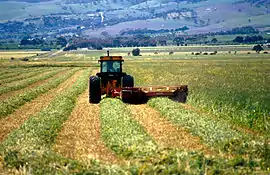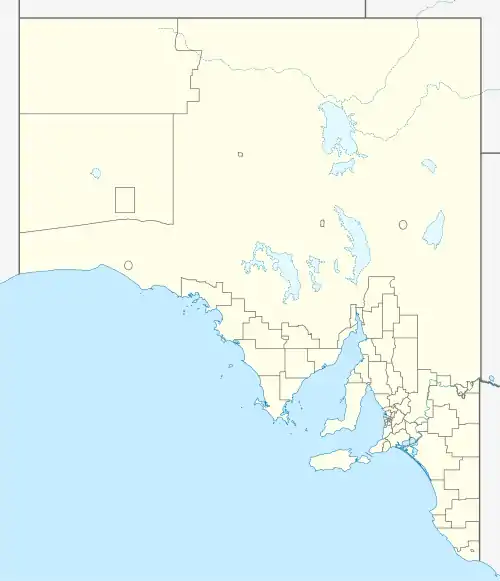Aldinga, South Australia
Aldinga /ɔːlˈdɪŋɡə/ is a suburb of Adelaide in South Australia located about 45 kilometres (28 miles) south of the Adelaide city centre in the City of Onkaparinga. It is a small suburb (population around 573 in 2016), about a kilometre east of the edge of the larger suburb of Aldinga Beach, and about 3 km (1.9 mi) from the beachfront.
| Aldinga South Australia | |||||||||||||||
|---|---|---|---|---|---|---|---|---|---|---|---|---|---|---|---|
 Cutting hay near Aldinga, south of Adelaide in South Australia, 1992 | |||||||||||||||
 Aldinga | |||||||||||||||
| Coordinates | 35.267°S 138.483°E | ||||||||||||||
| Population | 764 (SAL 2021)[1] | ||||||||||||||
| Established | 1857 | ||||||||||||||
| Postcode(s) | 5173 | ||||||||||||||
| LGA(s) | City of Onkaparinga | ||||||||||||||
| Region | Southern Adelaide[2] | ||||||||||||||
| County | Adelaide[3] | ||||||||||||||
| State electorate(s) | Kaurna[4] Mawson[5] | ||||||||||||||
| Federal division(s) | Mayo | ||||||||||||||
| |||||||||||||||
| |||||||||||||||
| Footnotes | Climate[6] Adjoining suburbs[7] | ||||||||||||||
History
Aboriginal use
Before British colonisation of South Australia, the Kaurna people occupied the land from the Adelaide plains and southwards down the western side of the Fleurieu Peninsula. There was a camp at Aldinga known as Camp Coortandillah, and Kaurna people were present living in the Aldinga Scrub until the 1870s, when Bishop Augustus Short sent the remaining people to the mission at Poonindie, thus ending their occupation of the area. After they were removed, some Aboriginal people from the Goolwa area (Ngarrindjeri people) occupied the area. The Kaurna language name of Aldinga was Ngaltingga.[8]
European history
After British colonisation of South Australia, Aldinga started as a town in the 1850s in response to the development of farming on the Aldinga Plains. The layout of the town in circa 1857 is attributed to Lewis Fidge, a local farmer. The town is reported as growing quickly with the construction of a "hotel, church, blacksmith's shop and a number of other shops and trades". In the 1870s, the combination of declining productivity of the land and opportunities such as the availability of land in South Australia's mid-North resulted in a population decline. However, the town survived due to its location on the Old Coach Road which continues south to towns along the east coast of Gulf St Vincent as part of what is now called the Main South Road.[9] Aldinga Post Office opened around 1851 and closed in 1992.[10]
Popular culture
The bands Another's Life, The Fall of Troy, I Killed The Prom Queen and Spirit of Alondray come from Aldinga.
See also
References
- Australian Bureau of Statistics (28 June 2022). "Aldinga (Suburb and Locality)". Australian Census 2021 QuickStats. Retrieved 28 June 2022.
- "Southern Adelaide SA Government region" (PDF). The Government of South Australia. Retrieved 17 April 2017.
- "Search result for "County of Adelaide, CNTY" with the following data sets selected - "Counties" and "Local Government Areas"". Property Location SA Map Viewer. Government of South Australia. Retrieved 24 April 2017.
- "2014 State election boundaries". Electoral Commission SA. Retrieved 17 October 2014.
- "2014 State election boundaries". Electoral Commission SA. Retrieved 17 October 2014.
- "Monthly climate statistics: Summary statistics Noarlunga (nearest weather station)". Commonwealth of Australia , Bureau of Meteorology. Retrieved 4 February 2017.
- "City of Onkaparinga suburb boundaries map". City of Onkaparinga. 9 January 2014. Archived from the original on 24 September 2015. Retrieved 8 October 2014.
- Amery, Rob (2016). Warraparna Kaurna!: Reclaiming an Australian language (PDF). University of Adelaide Press. pp. 73, 94, 204. doi:10.20851/kaurna. ISBN 978-1-925261-25-7.
- "European History and Heritage - suburb profile, Aldinga". City of Onkaparinga. Retrieved 4 November 2014.
- Premier Postal History. "Post Office List". Premier Postal Auctions. Retrieved 26 May 2011.